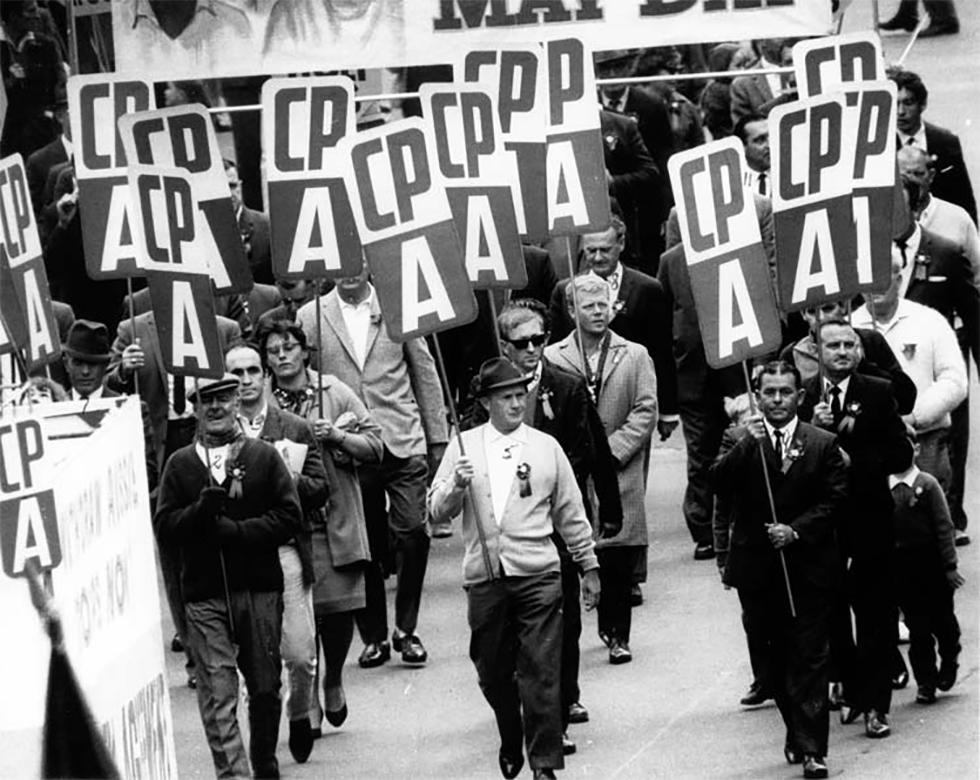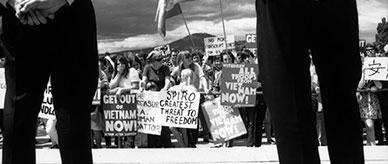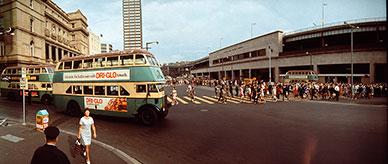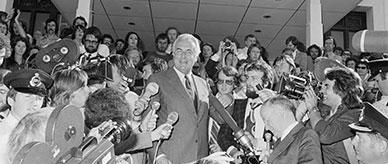


About this record
This is a black-and-white photograph taken by the Australian Security Intelligence Organisation (ASIO) on 1 May 1966 showing members of the Communist Party of Australia (CPA) marching in a May Day rally in Sydney. There are at least four lines of marchers, mostly men, but including at least one woman and two children. The marchers are carrying placards marked 'CPA', and appear to be wearing on their chests identical badges with ribbons. The man in the second line from the right, four back from the front, is Laurence ('Laurie') Aarons, the CPA's National Secretary. The number '8' appears on his collar, having been written there after the print was made. The images of some of the other marchers have also had numbers written on them, but these marchers are not believed to have been senior party officials.
Educational value
- Shows a May Day march – May Day, on 1 May, has been used since the late 1800s as a day to celebrate the achievements of the labour movement, notably the 8-hour working day; the union movement still conducts May Day marches, but the achievements of the labour movement in Australia are mainly commemorated on a public holiday called Labour Day, which is held on different dates in the different states and territories.
- Relates to communism – communism is a political and economic theory aimed at achieving a classless, egalitarian society by replacing capitalism with communal ownership of all property and all means of production; various schools of communist theory, particularly those associated with the German philosopher Karl Heinrich Marx and the first leader of the Soviet Union, Vladimir Ilich Lenin had a major influence on world politics in the 20th century; countries such as China, Vietnam and Cuba still have communist governments.
- Features members of the Communist Party of Australia (CPA) – founded in Sydney in 1920, the CPA reached a peak membership of about 20,000 in the 1940s, and it had significant roles in various industrial conflicts and protest movements before it was officially wound up in 1991; the Socialist Party of Australia, which was formed in 1971 by breakaway members of the 'old CPA', changed its name to the Communist Party of Australia in 1996.
- Shows members of an Australian political party that was subject to Federal Government prohibition – the CPA was banned for about three years during the Second World War but the ban was lifted after the Soviet Union joined the Allies in the fight against Nazi Germany; the CPA later survived attempts by the Liberal Party Prime Minister Robert Menzies to have it banned again, through legislation in 1950, and through a referendum in 1951.
- Relates to the Australian Security Intelligence Organisation (ASIO) – ASIO was established on 16 March 1949 after a US and British code-breaking operation revealed that sensitive government information was being passed to the Soviet Union from a source in Australia; for decades, Soviet espionage remained ASIO's main focus, but in more recent years it has increasingly focused on violence motivated by political, ethnic or religious beliefs.
- Is an example of a surveillance photograph taken in an ASIO operation – during the geopolitical and economic struggle known as the Cold War (1947–91), Australia was part of the Western alliance led by the USA; ASIO regarded the CPA as a security threat because the 'other side' in the Cold War comprised communist countries led by the Soviet Union.
- Relates to Laurence ('Laurie') Aarons (1917–2005), National Secretary of the CPA between 1965 and 1976 – Aarons left school at the age of 14 to join the CPA and become a 'professional revolutionary' at the height of the Great Depression; at a meeting of communist parties in Moscow in 1969, he was one of the few who criticised the Soviet invasion of Czechoslovakia that had occurred the previous year, as well as other Soviet policies under the leadership of Leonid Brezhnev; this led to a split in the CPA and the withdrawal of Soviet support from the Australian party.
- Is an example of an ASIO photograph released under the Archives Act 1983 – this legislation gave the public access for the first time to ASIO records, and Laurie Aarons used it during his retirement to view almost 1000 files on himself and the CPA.
Acknowledgments
Learning resource text © Education Services Australia Limited and the National Archives of Australia 2010.
Related themes
Need help with your research?
Learn how to interpret primary sources, use our collection and more.



